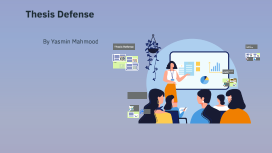Thesis Proposal Defense
Transcript: Thesis Defense Research Methodology Thesis Defense Recommendations Research Design Participants -The participants were six (6) female Arab students (20-40 years old). -They were enrolled in different majors( in-person classes) and backgrounds. -Students with different proficiency levels. -Future research should explore the integration of the established theories like SDT, EVT, and ST and the role of technology in language learning motivation. -Professors should encourage participation and provide constructive feedback to reduce student’s fear of judgment. -Group work and classmate feedback can help students practice speaking in a stress-free setting. By encouraging the use of language learning apps, podcasts, and other digital tools to promote language learning, the instructors can provide students with the opportunities to prepare for speaking exercises, such as pre-class readings or discussions to boost their confidence. By addressing these factors and implementing these strategies, educators can help female Arab students overcome barriers to participation and enhance their English-speaking skills. -Future research may explore how these findings apply to other contexts, such as online language learning and help to improve our understanding of motivational factors in language learning. This research adopts a qualitative approach, A Descriptive Case Study. The Role of Language Learning Strategies in Motivating Female Arab Students in the United States to Improve their English-Speaking Skills: A Descriptive Case Study By Yasmin Mahmood Data Analysis Background of the Study. -Motivation is crucial for language learning, particularly in developing speaking skills for effective communication. It empowers learners to engage with the language and overcome challenges, with intrinsic (personal interest) and extrinsic (external rewards) motivation both playing significant roles. -Language learning strategies (LLS) are essential tools that enable students to acquire and use a new language effectively, enhancing their proficiency and achieving their goals. Instruments -Semi-Structured Interviews were used as the instruments of data collection. -The questions were presented in Arabic and English. The participants were able to choose to answer either in Arabic or in the English language. Implications -These findings revealed that professors can assist female Arab students by implementing teaching strategies that promote social communications, structured approaches, and emotional consolation. -It demonstrated how both intrinsic and extrinsic factors play vital roles in motivating female Arab students to participate in speaking activities. -The participants indicated that instructor encouragement and classmate support advanced their motivation, aligning with existing theories on extrinsic motivation (Ryan & Deci, 2000). Additionally, the desire for social interaction is a key factor in motivating participation, emphasizing the significance of relatedness as abstracted in SDT. -These insights can positively influence future teaching practices, suggesting that professors should include more interactive, socially supportive environments, and encourage the use of varied language learning strategies to help students develop their speaking skills in interesting and motivating ways. Professors and language programs can improve students’ participation by encouraging a supportive classroom environment, fostering the use of effective language learning strategies, and providing opportunities for social communication. -This research revealed several new findings that have not been extensively discussed in existing research, such as the role of technology in affective strategies. Participant 6 used technology (e.g., recorder, recording herself, using applications) not only for cognitive objectives but also to dealwith anxiety and build her confidence, marking a double use of technology for cognitive and affective strategies. -cultural sensitivity in social strategies were expressed by Participants 5 and 6, who mentioned that cultural differences, such as the fear of being judged by native speakers, impacted their motivation. This point highlights the need for culturally sensitive education approaches that is an underexplored area in language. -There are some contradictions. While SDT highlighted intrinsic motivation, Participants 1 and 2 also highlighted extrinsic factors, such as academic requirements, as motivators, which suggests that extrinsic motivation can coexist with intrinsic motivation in language learning. -Compensation strategies were less frequently used compared to other strategies, which contradicts Oxford’s (1990) assertion that compensation strategies are critical for language learners. -This lackvmay be due to my participants’ focus on active learning rather than relying on compensatory techniques. -The participants’ dependence on cognitive and metacognitive strategies, such as preparation and self-monitoring,

















